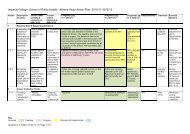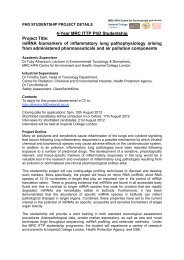Dr Tami Kramer Slides
Dr Tami Kramer Slides
Dr Tami Kramer Slides
You also want an ePaper? Increase the reach of your titles
YUMPU automatically turns print PDFs into web optimized ePapers that Google loves.
What have we learned:adolescent depression in primary care matters<strong>Dr</strong> <strong>Tami</strong> <strong>Kramer</strong>Consultant Child & Adolescent Psychiatrist/Senior Clinical Research Fellow
The pathway to psychiatric careModified from Goldberg & Huxley (1980)SPECIALISTCAMHSService usePRIMARY CAREdetected patientsManagement in primary carePRIMARY CAREall patientsConsult primary careCOMMUNITYPerception of a problemREFERRAL FILTER 3RECOGNISE PROBLEM FILTER 2DECIDE TO CONSULT FILTER 1
Adolescent presentations to primary care(<strong>Kramer</strong> & Garralda 1998; Fernandez et al, 2009; Gledhill & Garralda 2011)• At least 50% registered consult in a year• 98% present with physical symptomsUp to 40% have psychiatric disorder (1yr)• 20% adolescent attenders recent depressive episode>50% depressed at 6mo
Adolescent presentations to primary care(<strong>Kramer</strong> & Garralda 1998; Fernandez et al, 2009; Gledhill & Garralda 2011)• Associations drug & alcohol misuse, health riskbehaviours e.g. risky sexual behaviour• Depression frequently unrecognised by GPsBut better in more severe and more impaired• Potential for detection & intervention
Adolescent depression in primary careDetection• Influenced by:Expression of concern / help seeking• Need:Enhance public awarenessTraining for frontline providersImprove diagnostic skills (?screening tools)Develop primary care based i/v’sBetter co-ordination with CAMHS
Therapeutic Identification of Depression inYoung People (TIDY)• TIDY Team:Imperial College UCL Lonsdale Med Centre<strong>Tami</strong> <strong>Kramer</strong> Steve Iliffe Lisa MillarElena GarraldaAmanda ByeJulia GledhillMar VilaVictoria Fernandez
Therapeutic Identification of Depression inYoung People (TIDY)• Training in identification & brief intervention fordepression• Rationale:• Morbidity hidden, common in attenders• Frequently unrecognised• Re-attendance for specialist Rx poor• Opportunistic ‘single shot’
• Video TIDY consultation
TIDY Training• 2 X 1hr sessions (& manual + desktop aids)• Seven principles– Consider known stressors– Consider seeing y.p. alone– Shift focus of consultation– Use general psychiatric screening questions– Clarify sx depression– Diagnose depression Referral guidelines– Brief intervention
TIDY Intervention• Psycho-education + leaflet• Offer empathy- note stressors• Positive re-inforcement• Advise:• Identify confidant• Increase activity• Self monitoring & self re-inforcement• Invite back / follow up
TIDY: Proof of Concept StudyGledhill et al, 2003• Piloted in single large General Practice in London• GP identification• mood symptoms (3mo)• functional impairment (3 mo)• Young people positive feedback
Lisa’s story:Ten years ago I had just joined as a new partner at Lonsdale. Agroup of child psychiatrists came to the practice to train us toidentify mild depression in young people and manage those weidentified. They said we could fit this all in to a 10 minuteconsultation.My first reactions were very negative. How could I possibly fit thisin? How could anything so brief work? Oh no, not more work!Surely depression = +++ counselling. And why would I want to bedoing that anyway, I’d rather leave it to the experts.
However, following the training (very grudgingly) I found that:• The research showed that it was useful• It was simple once you got the hang of it• It empowered me to ask questions of young people who mayfind it difficult to articulate their feelings. I am no longer soscared of uncovering depression in young people.
TIDY:FEASIBILITY STUDY(<strong>Kramer</strong> et al 2012; <strong>Kramer</strong> et al 2013)• 4 group practices31 practitioners (GPs & nurses)• Variable use of TIDY methods• Significantly improved confidenceSignificantly increases identification rate(from a very low baseline)
TIDY: Qualitative StudiesHow do you bring about change? Iliffe et al, 2004, 2011• PCP change related to:Time constraintsPersonal capacity & capabilityMatching tools to usual working stylesLocating boundary between ‘normal’ mood change & depressionConcerns regarding medicalisationAcquisition of new skillsPrefer selective use
TIDY: Qualitative Studies Iliffe et al, 2004, 2011• Longstanding debatesAttitudes to psychiatry & adolescents
“Difficult to communicate with”
“Adolescents are complex”
“Mood changes are normal”
TIDY Conclusions?Therapeutic identification possible within 10 min cons.• Broader dissemination?• How do you maintain practitioner change?• Combine debate with action?Acceptable to young people• Trial of effectiveness needed• Treatment readiness?Embed within collaborative care model?
Time for intervention for adolescent depressionin primary care to come of age?
















